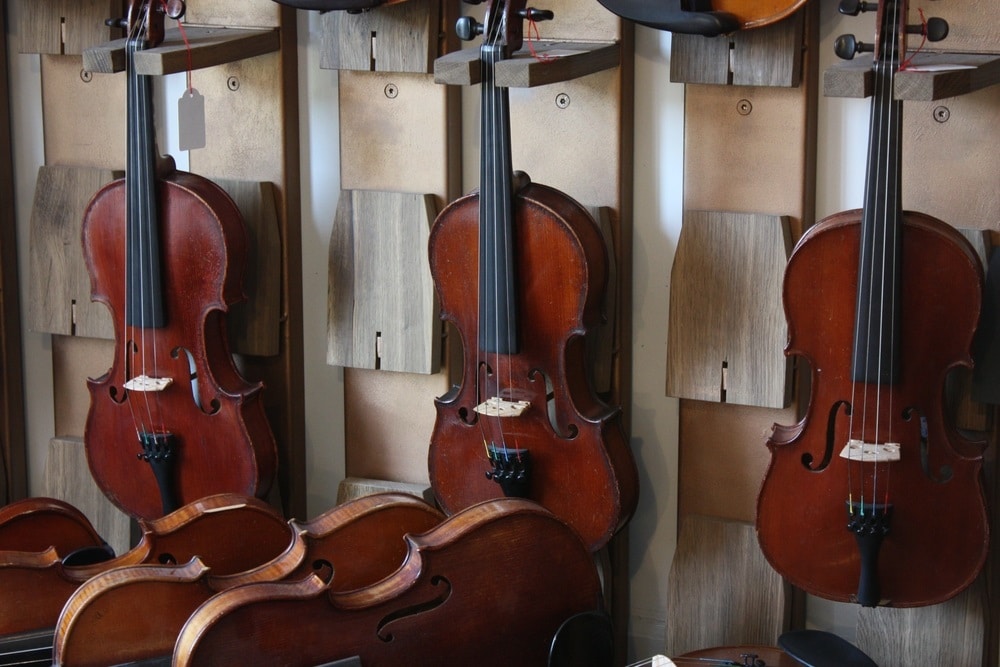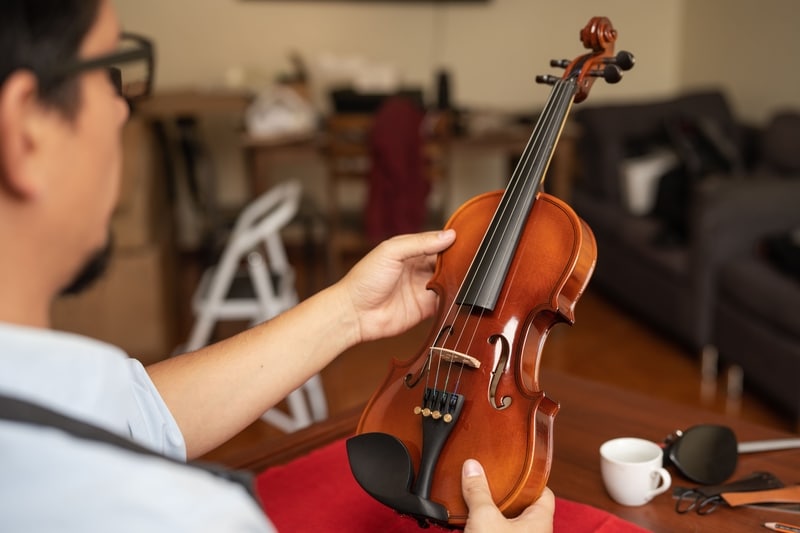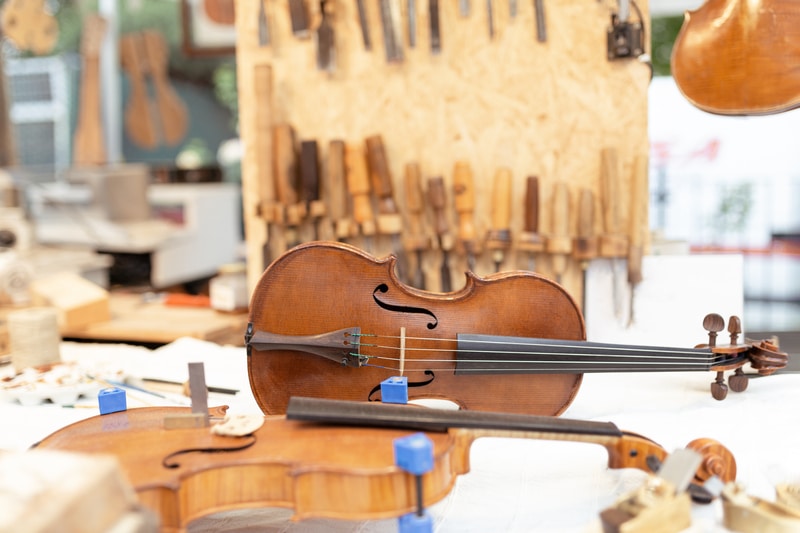
The violin has become such a familiar instrument to us these days that it is perhaps difficult to imagine the humble origins from which it came.
It can also be quite a challenge to imagine a musical landscape devoid of the violin entirely, but in the early part of the Baroque Era, this was certainly the case. During these times, the viol family of string instruments took centre stage and continued to do so even as the violin evolved.
The Evolution of the Violin
Origins of the Violin
Whilst the viols were perfectly serviceable instruments, they produced quite a thin almost metallic tone that offered little in the way of projection.
That brittle sonority has its appeal, but it also has distinct limits, especially if you’re in the market for a string instrument that can comfortably act as a soloist and an ensemble player. This is where the origins of the violin begin.
Early Violin Makers
Andre Amati from Cremona and Gasparo di Bertolotti from Salon, both in Northern Italy, are thought to be the first two creators of the earliest versions of the violin.
Precise dates for these instruments are not available; however, surviving Amati violins are thought to date from around 1565. This is a time further back in history than one might at first imagine.
There is some evidence to suggest that Amati (1505) may have been manufacturing violins as early as 1520, but no instruments from this period have survived.
Cremona saw the advent of another genius, Antonio Stradivari. His name is perhaps best known amongst violin makers and for good reason. His instruments remain amongst the most sought-after even today, selling for millions of dollars when they come to auction.
In recognition of Stradivari’s huge contribution to the violin, a statue of him can be found in Cremona. What is remarkable is that despite Amati and Stradivari both living in Cremona, they had nothing to do with one another and developed their unique style of violin-making independently.
Whether an Amati or a Stradivari violin, each had a distinct set of characteristics that set them apart from all others.
Cremona as a Creative Hub
You may be wondering what it was about Cremona that caused such a revolution in instruments and design to occur. The answer is quite simple. Cremona was a bustling, creative hub full of artists, artisans, and inventors.
It was a place of considerable commercial activity and one that was successively fought over throughout the Mediaeval period. It held strategic importance that caused conflict while providing an enthralling experience for the European traveller.
From resources such as timber and stone to the very latest instrumental invention, Cremona could deliver it all.
Design and Innovation in Violin Making
Amati’s violins were from the outset astonishing pieces of design that demonstrated incredible woodworking skill. Such was the level of Amati’s innovation with these violins that many of the techniques and approaches to creating violins amongst the Amati family did not change for two centuries.
The Amati violins were not only visually appealing but instruments of great refinement and delicacy. As the 17th century rolled on, the exporting of these new instruments to France, England, and further afield became big business.
Such was the reputation of the Cremona violin manufacturing that the word Cremona became synonymous with the violin. Manufacturing spread across Europe, with many keen to tap into this new and exciting market. Very few, however, came close to the standards that the Amati family set in place.
Impact of the Plague on Violin Making
The Plague that swept across Europe during the 17th Century worked quite nicely in favour of the Amati family business. Many of those who tried to copy their work often created noticeably inferior violins and cellos and were killed by the terrible outbreak of plague.
The effect of this tragic event took its toll on the artistic community but did have a positive outcome for this particular family of instrumental inventors.
Stradivari’s Unique Contributions
Returning to the other major contributor to the early emerging world of the violin, Antonio Stradivari was the exception, never the rule. By the time the Great Fire of London (1666) was tearing through the capital city of England, Antonio Stradivari was already making violins.
Interestingly, his origins are shrouded in a degree of mystery as is his possible association with the Amati family. Sources seem to suggest that Stradivari’s skills and genius had nothing to do with the Amati family, even though they shared the same city.
What we do know about this revolutionary violin maker is that he was relentless. He tirelessly laboured over the dimensions, shape, and overall appearance of his violins.
Whilst the later Amati violins appeared to lose some tonal qualities, the Stradivari violins soared above them with an almost unparalleled tonal projection.
Not only did Stradivari progressively refine his instruments, he also built his business through his persistent pursuit of the wealthy and influential.
The violins made in the latter part of the 17th century were not only highly decorative and stunningly individual in appearance; they were outstanding violins whose quality was unmatched. Stradivari worked until his death at the age of 91 in 1737, never giving up on improving his work.
Post-Stradivari Violin Making
Following the death of Stradivari, violin-making, notably in Cremona, tailed off. There appeared to be a living fear of trying to meet the incredibly high standards the Master had set, which caused a hiatus.
Guarneri del Gesu (1698-1744) continued to produce violins of considerable quality. His violins may not have been as elaborate in appearance as Stradivari’s, but their power and sonority equally matched.
These instruments are highly prized today, with the tonal colour often described as being rich and darker than the Stradivari violins.
From then until now, you will hear violinists refer to the Italian sound. What they are referring to is the unique sonic properties of the work of Amati, Stradivari, and Guarneri del Gesu.
There is no doubt that these instruments represent the finest example of violins ever produced, but what happened after the death of these great creators was also not conducive to that perception changing.
Decline and Revival of Violin Manufacturing
Manufacturing of violins had, as you would expect, spread across Europe as the 18th century took hold. The problem was that the quality of what was being produced was noticeably inferior to what had gone before.
Manufacturers in England and Germany, for example, decided to focus on the cheaper end of the market and made instruments to suit. This only served to reinforce the evolving myth that the Italian manufacturers used secret wood, mystical manufacturing methods, and recipes for varnishes that could not be reproduced.
The great Italian violin makers indeed did use young properly seasoned spruce and had highly evolved technical abilities, but no dark secret to what they did.
The varnishing of the Cremona violins was and indeed still is heralded as extremely important in finishing the instrument, but it was the poor standards of other countries’ manufacturing that conjured the enigma of the Italian masters’ instruments.
As the 18th century reached a close, the manufacturing of violins in Cremona had seriously diminished. It wasn’t until the end of the century that the reputation of the Cremona violin makers began to be restored.
At this stage, some influential names emerge from the ruins, such as Giovanni Battista Ceruti and Giovanni Rota, who began the renaissance of the Cremona violin making. By the 19th century, Italian violin-making was back on track and leading the world once again.
Giuseppe Rocca and Giovanni Pressanda Francesco took the reins in this part of the century, working out of Turin and ensuring the longevity of high-quality violin manufacturing.
Emergence of New Manufacturers
At the same time, other notable violin manufacturers began to establish themselves in countries other than Italy. Late in the 18th century, we find Spanish manufacturers such as Joseph Contreras working in Madrid and Vincenzo Panormo, who successfully carved a career in London having left his country of birth, Italy.
Others followed, like Nicolas Lupot and Jean-Baptiste Vuillemme (1798 – 1875), who became one of the most important figures in violin manufacturing. Vuillemme’s work centred around producing copies of the early Italian masters.
He allegedly tried to convince the great virtuoso violinist Paganini that a copy he’d produced of Il Connone was an original. Paganini could only tell the difference by hearing the instruments.
JB Vuillemme was, however, one of the most important individuals to break through into the complex and competitive world of violin making. His instruments were of supreme quality and greatly coveted today.
Amongst his 3000 instruments were what became known as The Evangelists Quartet of instruments created between 1863 and 1872. Vuillemme named many of his instruments, and these took theirs from St Matthew, St Mark, St Luke, and St John. They are stunning examples of his craft.
Mass Production and Modern Developments
By the time the 19th century drew to a close, the manufacturing of violins on a large scale for purely commercial purposes became commonplace. From that point, the industry didn’t look back. Such was the success of violinists like Paganini that the instrument was immensely popular, and the demand needed to be met.
One important name that bubbles to the surface towards this period is John Juzek (the Anglicized version of his name). His workshops and indeed his industry were located in Bohemia, even though his vast output of violins, violas, cellos, and double basses is more closely associated with North America.
These instruments have been understandably popular and sold thousands of units across the world.
Another important violin maker is Suzuki. With their manufacturing base in Japan, the Suzuki empire has not only produced some of the modern world’s best violins but also an entire pedagogy.
The Suzuki company is one of, if not the most successful mass manufacturers of string instruments. Alongside their teaching methodology, Suzuki has made a major contribution to developing young musicians into some of the world’s finest players.
Contemporary Violin Makers
Naturally, the mass production of violins and distribution is global. The number of students learning the instrument must number into the millions, and not everyone could possess a Stradivari.
Alongside this are a significant number of bespoke violin makers, many of whom are producing instruments of impeccable quality and reputation.
According to Myluthier.com, the top five names to watch out for are Joseph Curtin, Francesco Toto, Gonzalo Bayolo, Stefan-Peter Greiner, and Paolo Vettori. One of Curtin’s violins sold in 2013 for a record $132,000.




